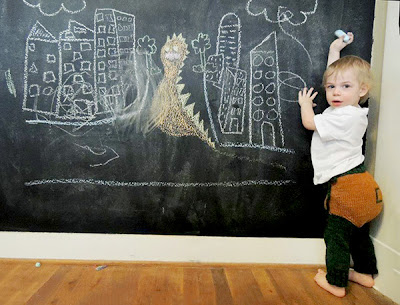The Baddies pattern is for monster and robot crocheted beanie dolls. Which are weighted so that they'll pop right back up when punched. These look perfect for the kind of small child who needs safe channels for his or her aggression. I totally would have made one or both of these for my nephew when he was little if I'd had the pattern. His preferred method of greeting me from the time he could walk until he was about five was to run towards me giggling happily when he saw me, just like his sisters did... but instead of holding his arms up to be picked up and hugged as they would, he'd wrap one arm around my legs and pound joyously on my kneecaps with his other fist.
Knit Kid and Purl Girl are only 1.5 inches tall, so make sure you have the patience to work on that scale. Then again even if it turns out you don't have the patience, at that size you may finish before you know it. I wouldn't be too inclined to make these as designed. They're really for knitters, not children, and many adults don't care for stuffed toys. If I knew a child who loved tiny toys, I'd consider making them as generic superheroes. I do like that they're of both genders.
The Halftone Hat was inspired by city skylines illustrations in comic books. This is a hat you make specifically for a child who loves superhero comic books.
The esoteric comic book appeal of some of these designs has been a little lost on me so far, but even I get the appeal of the Onomatopoeia sweater. It's funny and cute on its own merits, and reminds me of the screen captions that used to point up the fight scenes in the sixties Batman TV show, in which the arch criminal's henchmen used to just stand helplessly about, waiting to be punched or have their heads knocked comically together.
Super Suzy is totally cute, and I'd rather make an empowering friend like her than yet another princess or fairy doll.
The Wristbands of Fury would probably be great for a child who loves Wonder Woman and needs to deflect imaginary bullets, and who could use a pair of fingerless gloves.
The Wonder-ific set is really more of a toy than wearable, but wouldn't take long to make compared to the hours of fun a child who liked them would have in them. And of course they must be worn with a cape at all times.
Like the Halftone Hat above, the Bricklayer Hoodie is based on comic book illustrations, this time of buildings in comic books. And it's a cute design, but I would rejig the pattern to make the placket lie closed in front, and possibly add buttons, a zipper or a leather lacing. Even superheroes shouldn't expose their chests in chilly weather.
The Super Stealth Gloves make me smile. Some of these designs feel too meta, as though they are more the kind of thing that adults think children will enjoy than something a kid will really relate to, but I can easily imagine a child having a lot of fun with these. Don't be surprised if your child spends the entirety of say, your next trip to the grocery store reporting back to the Hall of Justice.
I'm not sure I really get the appeal of the Superpants design. At sizes running from newborn to two years, they're for children too small to understand the concept of superheroics, and they're not really all that appealing to adults. To me the orange shorts look like diaper pants worn over pants, and the green legs as though they're supposed to be skin rather than tights, which are both unsettling thoughts in their ways. I think I might like it better done in another colour and worn with a matching sweater that would complete the look. The pants on their own look a little random and unfinished.


























